Review: A Most Fearful Sacrifice- Gettysburg Done Nice
By Mitch Reed
Wargames tend to feature some of the most iconic battles in history and the fact that the battle of Gettysburg has so many titles shows its enduring popularity with gamers. I own many games on the battle and one of my first wargames was the 1977 version of Gettysburg from Avalon Hill. Some games on the battle are hits and some miss the mark, however, A Most Fearful Sacrifice (AMFS) from Flying Pig Games is the best game on the battle if not also a top ten wargame in your collection. Designed by Hermann Luttmann, who we interviewed before the Kickstarter launch, the game is another in the “Blind Swords” series that cover the battles in the American Civil War. I have two games in this collection, Longstreet Attacks and The Devil’s to Pay, which cover different parts of the battle of Gettysburg. In AFMS Hermann has revamped the Blind Swords system and has produced an epic game that covers the entire battle.
Epic Battle, Epic Box
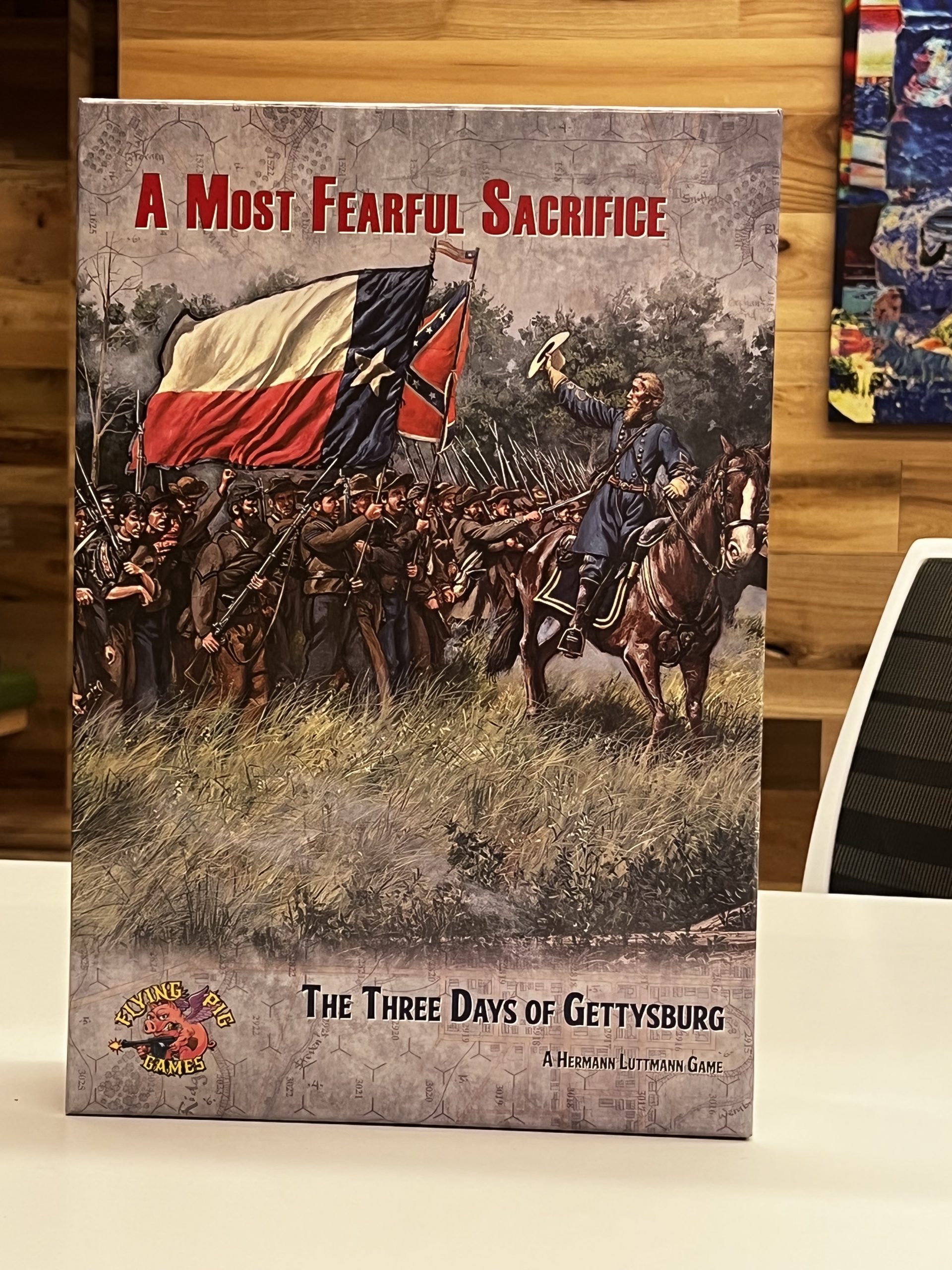
This game is huge! If you have ever purchased any game from Flying Pig, you know that the game will have large and thick counters and spectacular graphics. The game’s map, which covers sixteen square feet is a work of art and is another amazing map drawn by Rick Barber who sadly passed away recently. I do not know if AMFS was his final project, but it is a masterpiece and his loss is also a huge loss for our community.
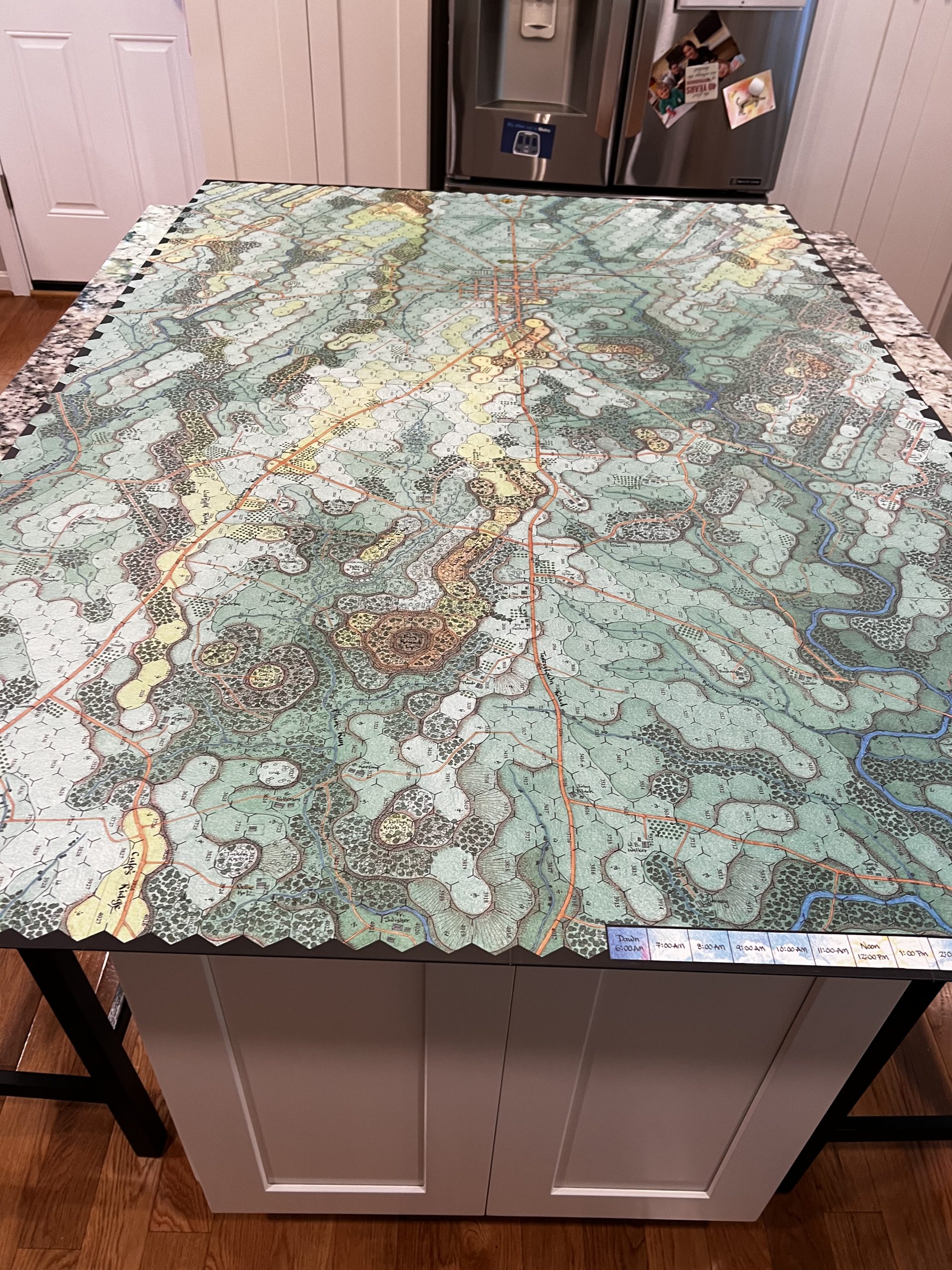
The game comes with two mounted maps, over five hundred counters, ninety cards, and a host of combat tables and player aids that makes the box one of the heaviest games I own. While some have complained that the components do not fit in the box, mine fit fine, even with the neoprene strips that isolate your map to the scenario you are playing.
When the game came out many gripped about the small print on the tables, and while I felt they were fine, I knew someone would upload the aids with larger print on Board Game Geek, which they did soon after the game was released.
The Units

In the previous versions of this game, the scale was smaller so units represented regiments, in AFMS the units are brigades however how they appear in the game is a bit different than in other games. Each brigade can have one to four counters with different ratings. While these may represent a brigade’s regimental breakdown it is not necessarily the case. As Hermann explained in the podcast, the breakdown was based more on how they were used operationally during the battle which is just a subtle touch that adds to gameplay.
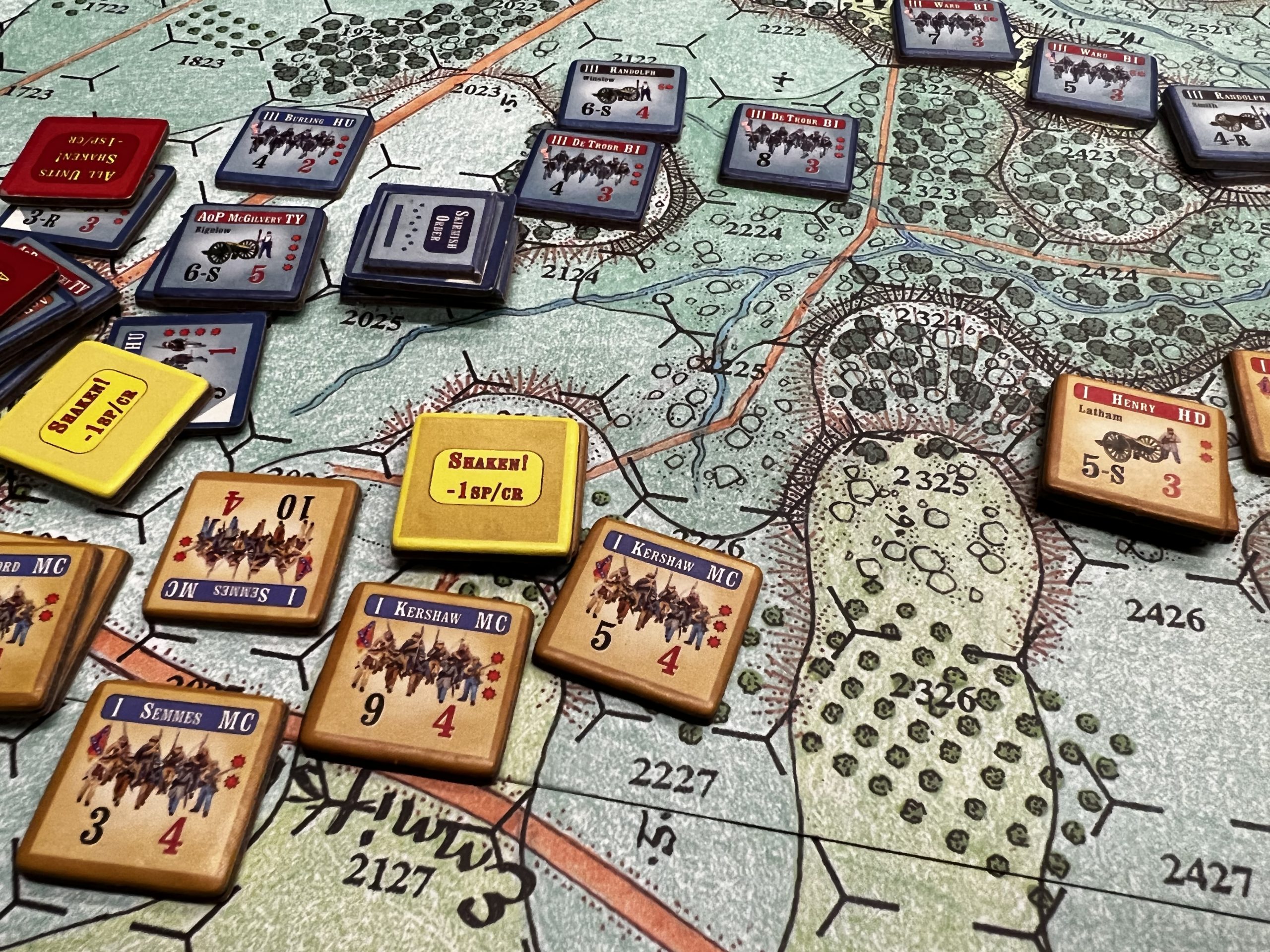
The counters represent the infantry, artillery, and cavalry (no, Jeb he misses the battle again) that were present during the battle. Each unit has a strength and cohesion rating and is double-sided. Each unit has a fresh side and when flipped over you can see its battle-worn side. With the use of “Shaken” markers, each counter really has five different statuses. Even if a unit gets “Broken” (taken off the map) there is a chance it can come back during the game.
The exception here is a “Crushed” result in assault, which means the unit is gone from the game. If a unit does come back it returns near another unit in its brigade or division, not marching in from off the table.
A mark of a good game to me is if the units in the game have the same characteristics and capabilities in the game as they would in real life. In AFMS they certainly do, and units such as Federal Cavalry (only Buford’s division is in the game), sharpshooters, and some US units which start in Skirmish mode can evade enemy units that close in on them so they cannot be assaulted.
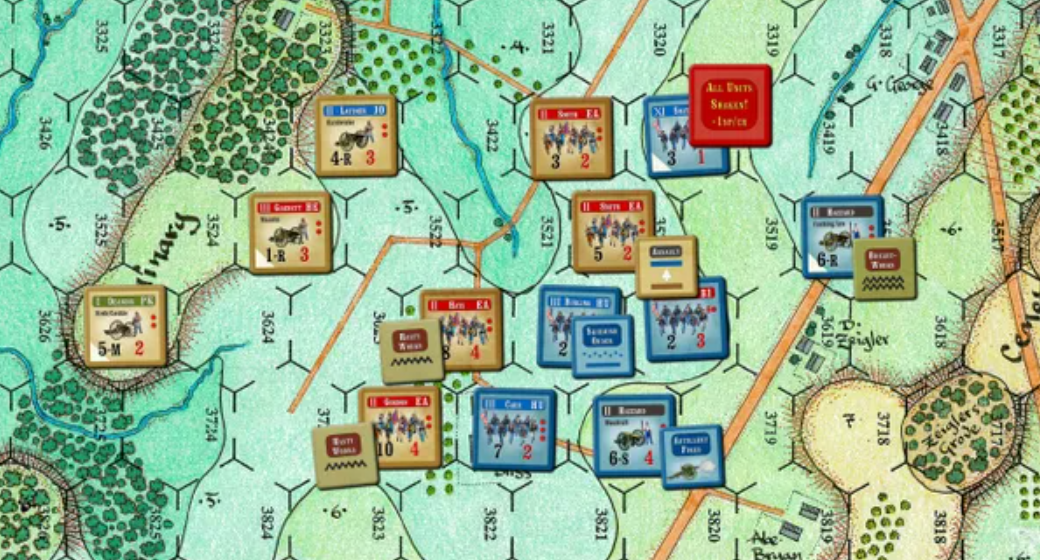
In AFMS, the Federal army has sharpshooters which retain this status all game and each scenario has some units that start in this mode. Once they remove this status there is no way to once again get in a skirmish formation.
Blind Swords
The two games in this series I had in my collection did not get much use past a quick solo run to see how the mechanics work. It was not that I did not like the game, which I did, but more because of the fact I have so many games to get to the table. In AFMS the chit activation used in previous games has been replaced by cards and with that change, the game’s mechanics have been upgraded, adding so much to a great system.
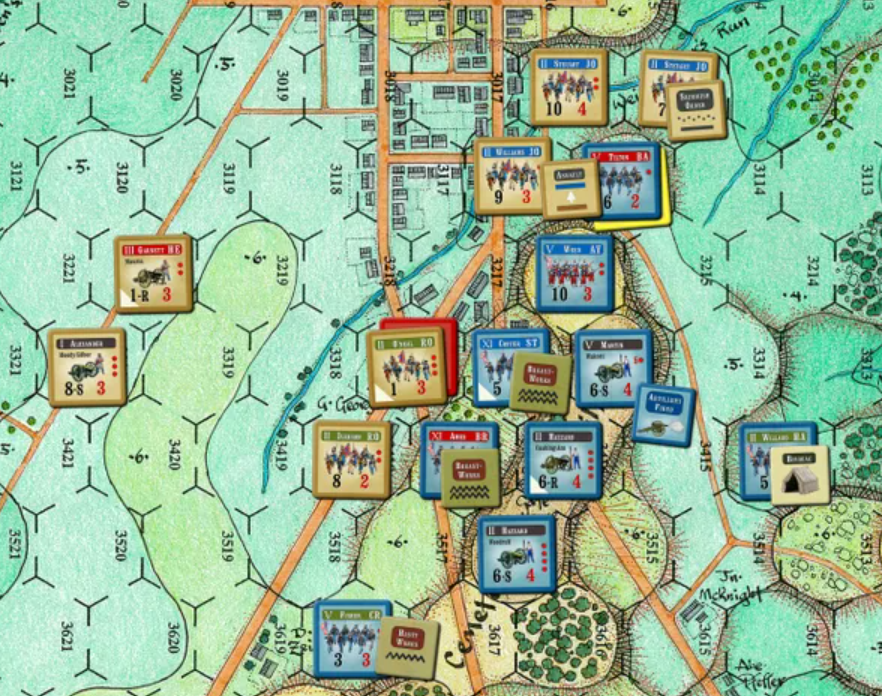
In AFMS, the two sides make a combined draw pile made up of corps activation cards, event cards, Friction of War cards, Fog of War cards, and CIC cards. The corps cards require you to roll a d6 that determines how many units of that Corps you can activate that turn. In most cases, this roll leads to you activating one of your divisions, which you have prioritized to move before the turn and then you roll again on the division card to determine how many of that division’s brigades and associated artillery you can activate in that phase. For corps with poor leadership, sometimes the corps roll is all you get.
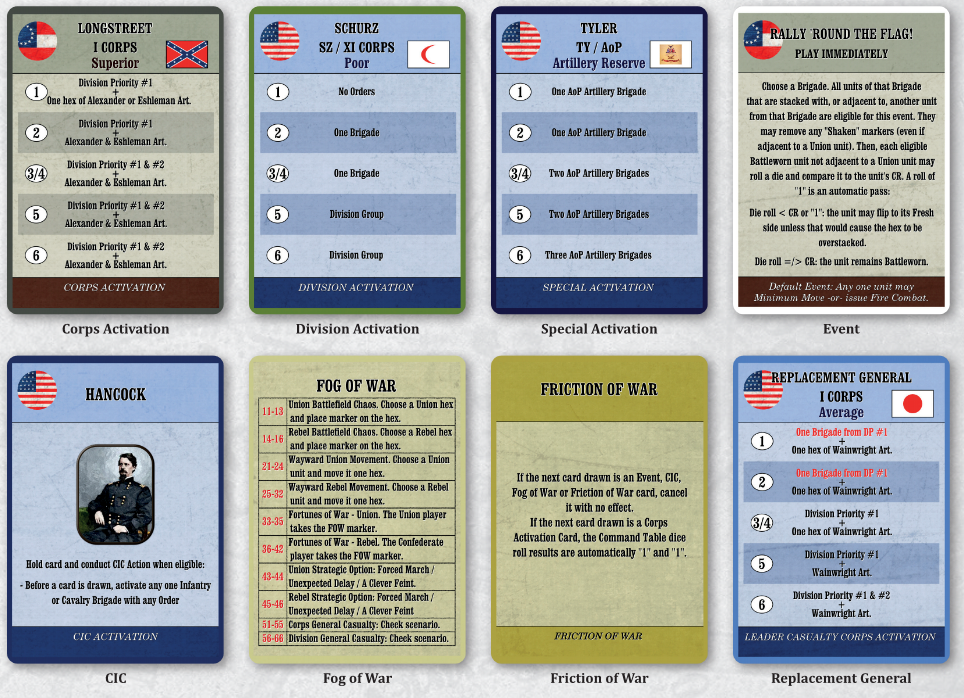
If you like easy-to-play game mechanics that have a lot of actions under the hood, then you can see how many things are at play in the card activation mechanic. It forces a player to plan out their turn in advance and represents how command and control worked on the black powder era battlefield.
The event and CIC cards also add so much to the game. The CIC cards give you another chance to activate a unit that may not be activated, such as a division that is your corps’ third priority or one that has already been activated. This card, which you can hold for use later in the turn gives you a lot of command flexibility.
The event cards also change the nature of the game in subtle or major ways. Some cards must be played right away and some can be held onto for when you can use them at key times during the turn. The Friction and Fog of War cards also can inject a black swan event in your game.
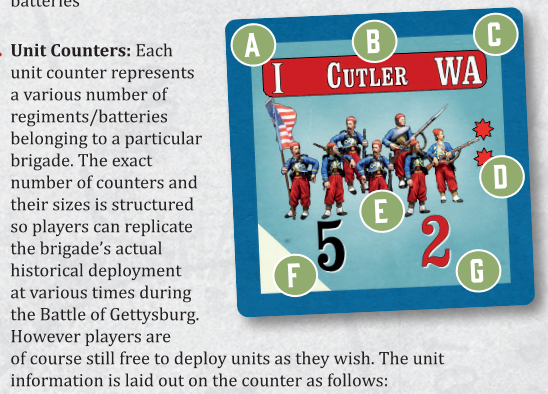
Another aspect I like about the card activation system is that the player who draws from the card pile changes each turn, so if you are drawing you can see your opponent’s cards every other turn and hide yours as well. During each turn the deck changes somewhat, activation and Fog/Friction cards are mandatory, however, the event cards you select can change turn to turn depending on how the battle is going. While many gamers dislike the community chit/draw/pull mechanic because one player can activate a few times in a row, the overall mechanic really works well to represent how battles in this era were fought.
The Anatomy of a Turn
Once you know which unit is getting activated in a phase you then have to determine what order they will receive and you have three to select from, attack, defend and maneuver. With an attack order, your infantry/artillery units have five movement points and eight for cavalry and can fire and enter into close combat. With a defend order your units can fire and can move one hex and cannot assault and in maneuver, your units have eight movement points (twelve for cavalry) and cannot engage an enemy unit.
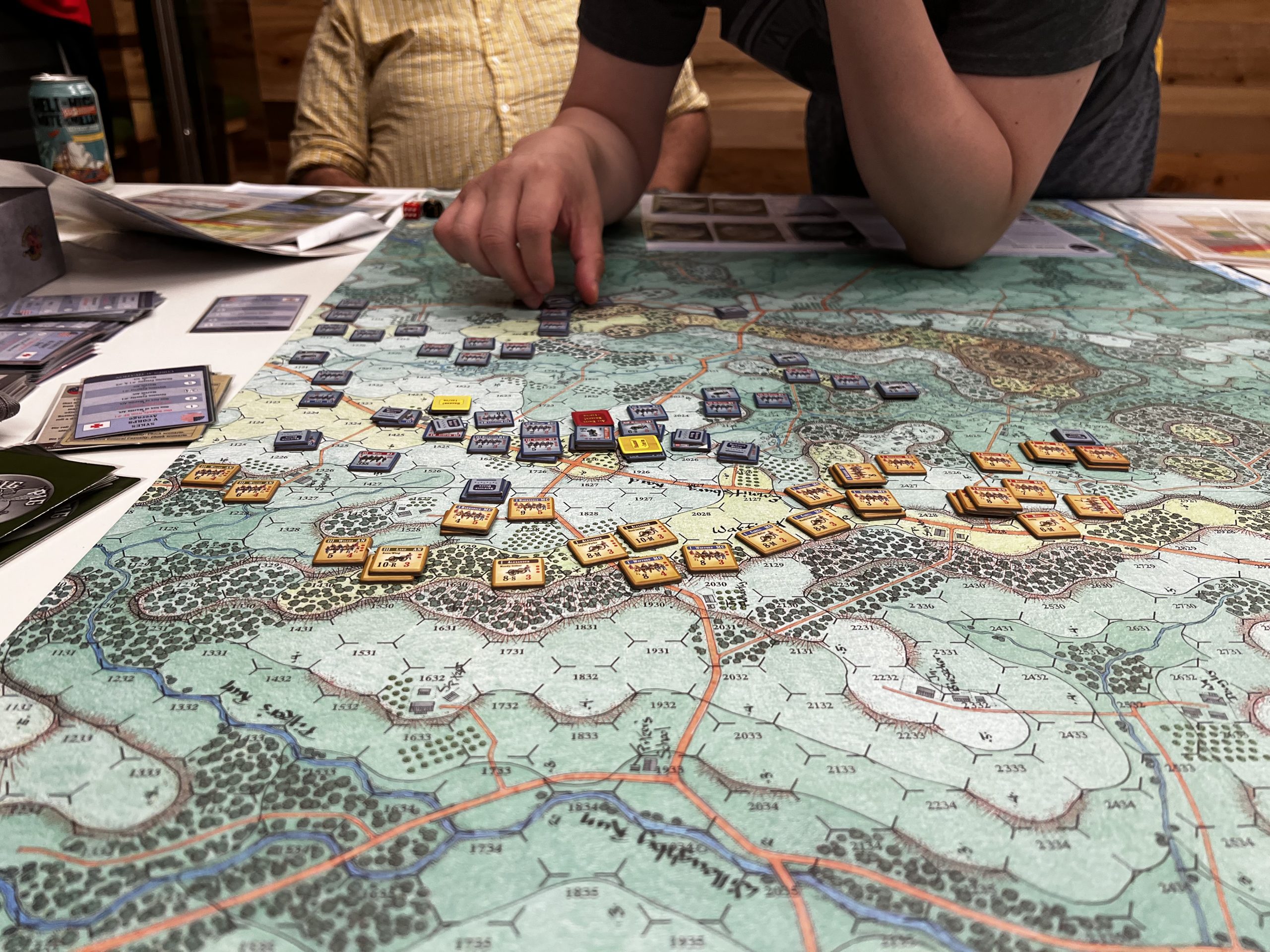
A turn starts off with a bombardment phase where each player can use at least one artillery unit to attack. Once units get activated in a phase they can shoot in fire step is and then move and if they are adjacent to an enemy unit under an attack order they can assault. In the rally phase units with a defend order can remove their Shaken markers and can roll to come back on the table from their Broken status as well as create “Hasty works” for defense.
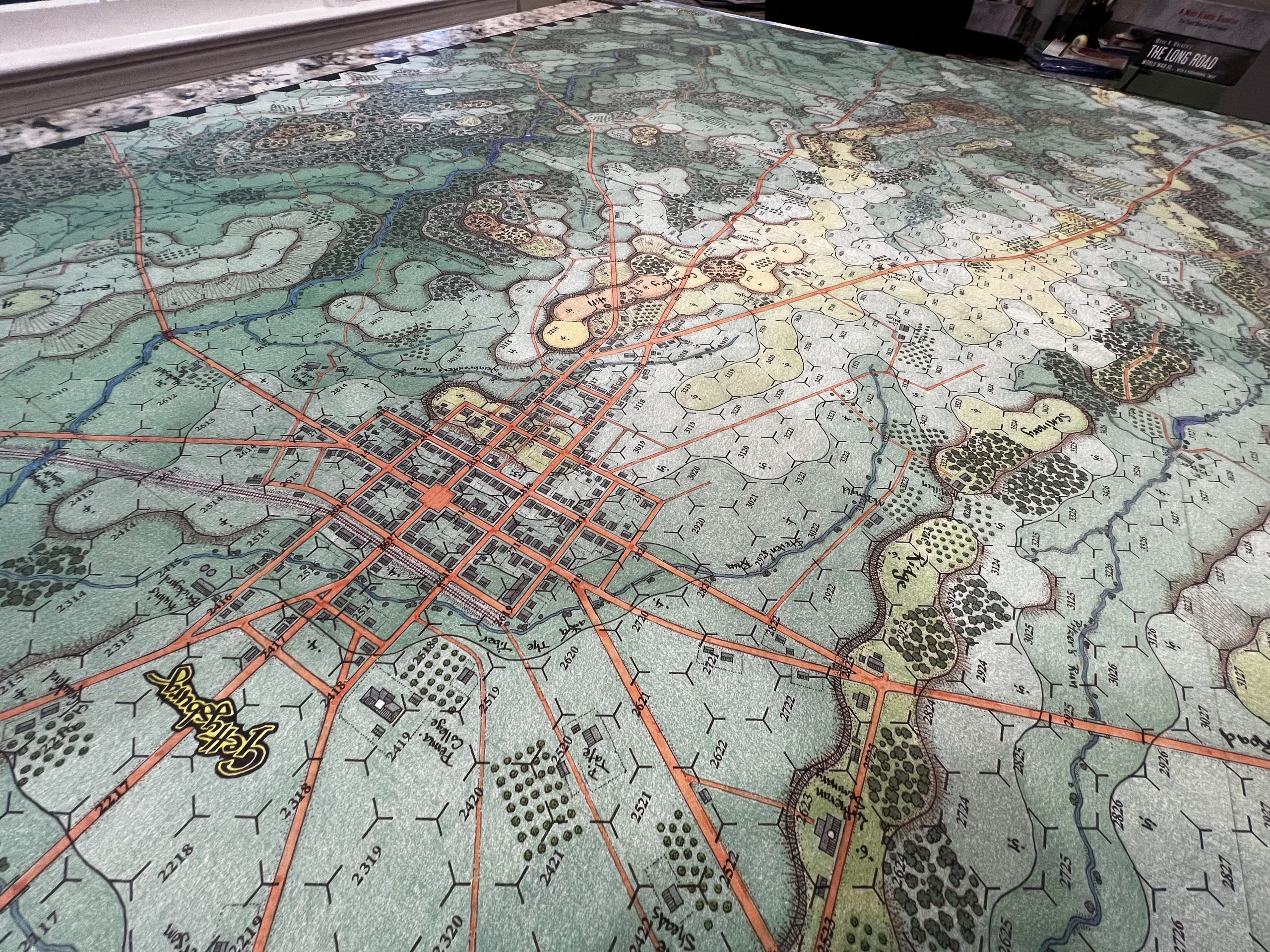
Each phase of a turn moves very fluidly and you are constantly making decisions on the fly. Even the non-phasing player as agency here with defensive fire and the ability to break off an engagement with certain units.
The Terrible Swift Sword
Combat in AFMS is interesting and involves a few steps. Each hex is limited to 10 strength points per attack so excess strength (in most cases you can have 20 SP per hex) is wasted and this shows how the designer factored the size of a firing line in the game mechanics. Once the column shifts are done (for range, terrain, etc) you roll a black, white, and red d6.
The black die is a factor of tens and white dice are single numerals, so a roll of 4,1 is a “41”. Once you cross-index your roll with your final SP column, the result can be “no effect” or five different severities of a cohesion test. The red die you previously rolled is added to the target unit’s cohesion rating and that is cross-indexed to the severity of the previous result and that gives you the final result.
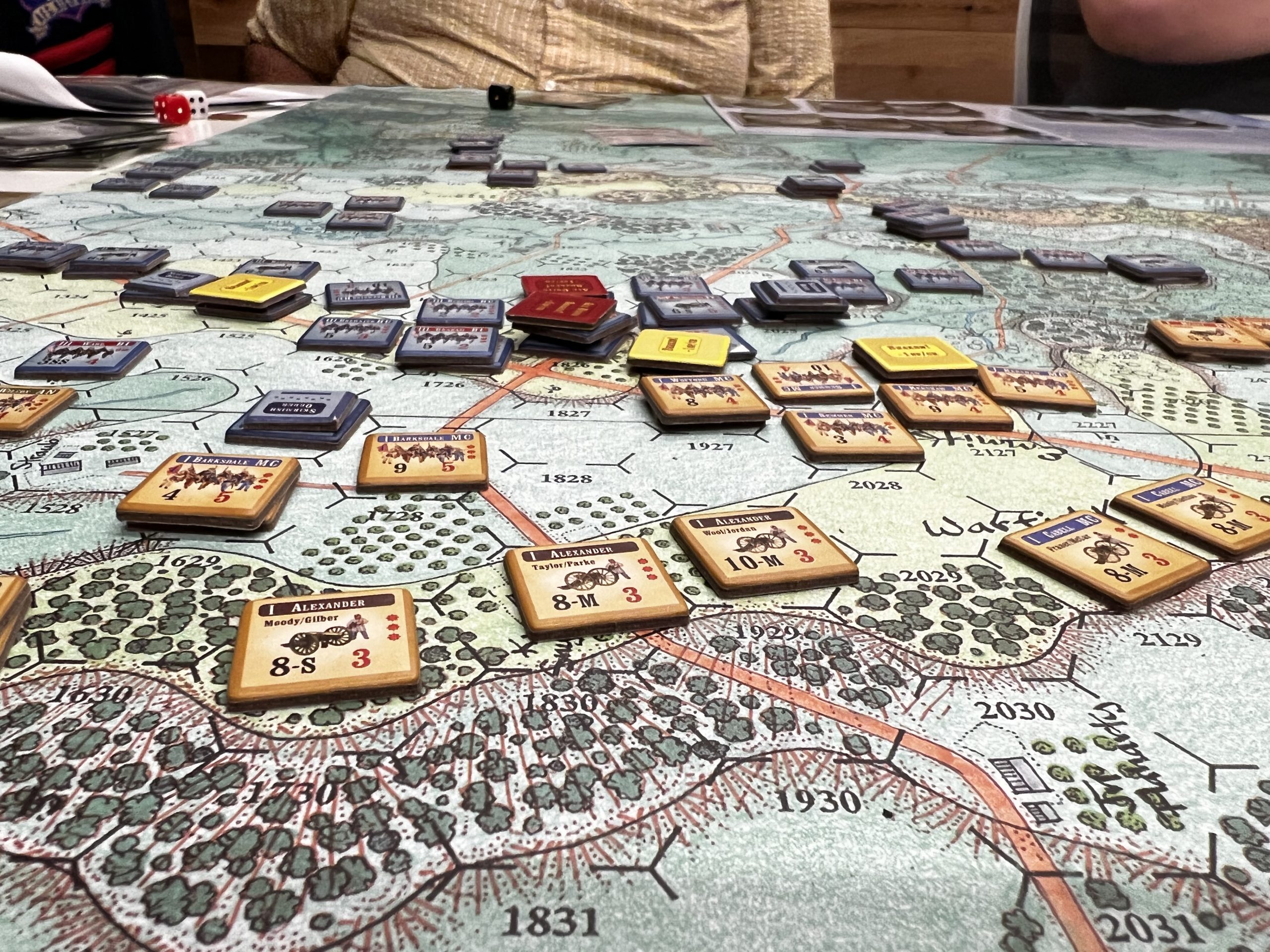
A unit can become Shaken, depleted (flipped over), or may have to Skedaddle. Another result, called “Firefight,” has the defending unit fire back. You can actually have rounds of firefights in the phase. Combat effects are cumulative, so if you are already Shaken you become Depleted.
The Skedaddle result is interesting, as you retreat your unit if you happen to go through another friendly unit they have to take a Panic Test, which can result in further units suffering a negative result. While the fire combat has you using two charts to get a result, the procedure is easy to pick up and really randomizes how fire combat is handled in the game. Assaulting is also a multi-step process and is very bloody and if you win your assault you can then move up and attack another hex.
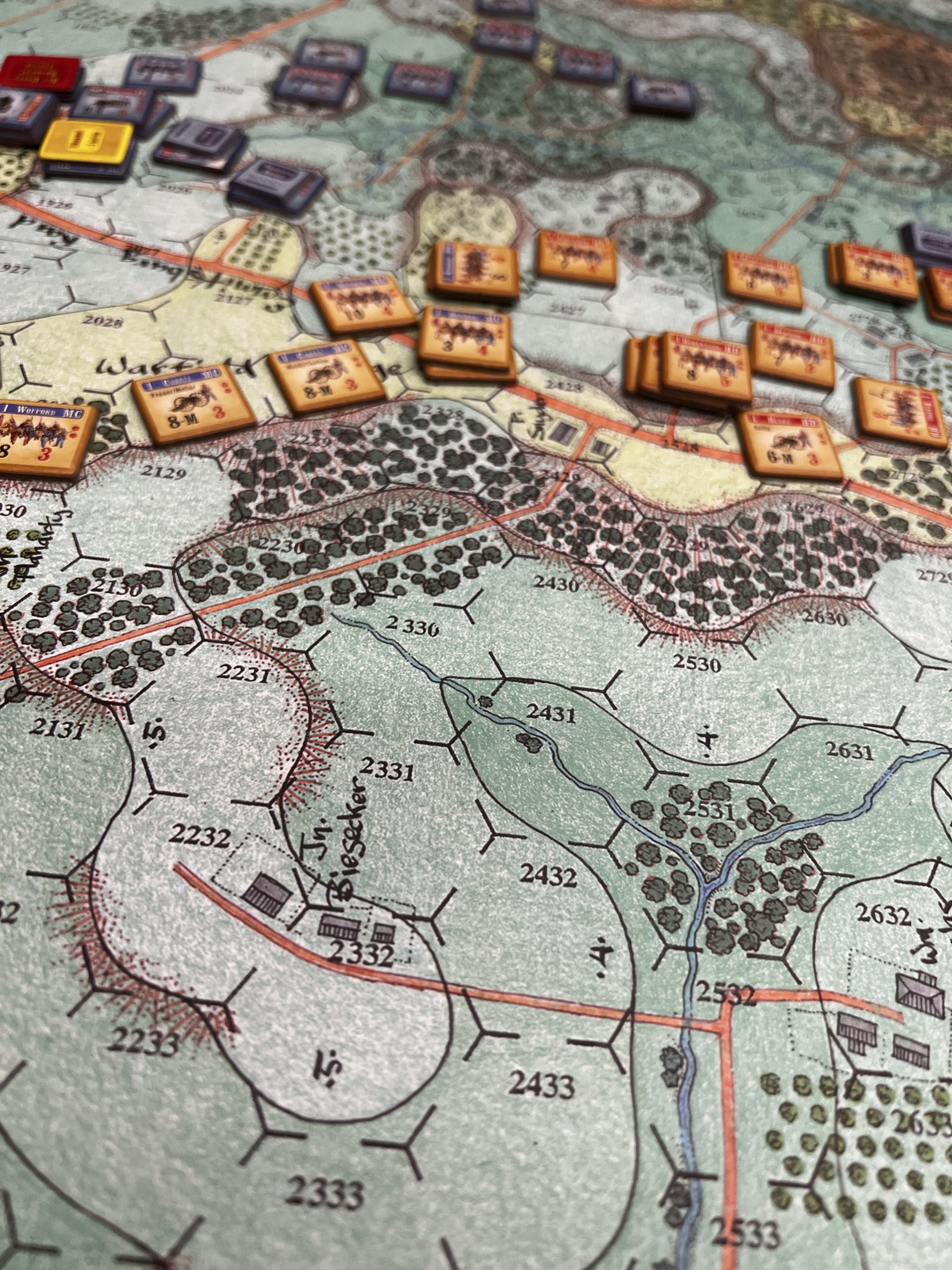
Overall, combat of the game is done very well and you need to smartly execute your attacks each phase. Some event cards do help out in combat and the fact that all rolls of doubles leads to a check of the Combat Events table with some interesting results.
Gameplay
I was lucky to get this game to the table within two weeks of delivery and I headed to Sebastian Bae’s place along with Zenobia winner Akar Bharadvaj to see how the game plays. Both of these guys are professional wargamers for their day jobs and have designed some hobby games as well.
We picked the “Longstreet Attacks” scenario since it covered the same fight as a previous Blind Swords title.
I also wanted to see how the game plays with multiple players. We had Akar commanding the Union III Corps and Sebastian took the US II and V Corps. I felt that this setup would also illustrate the position the III Corps was in on 2 July 1863.
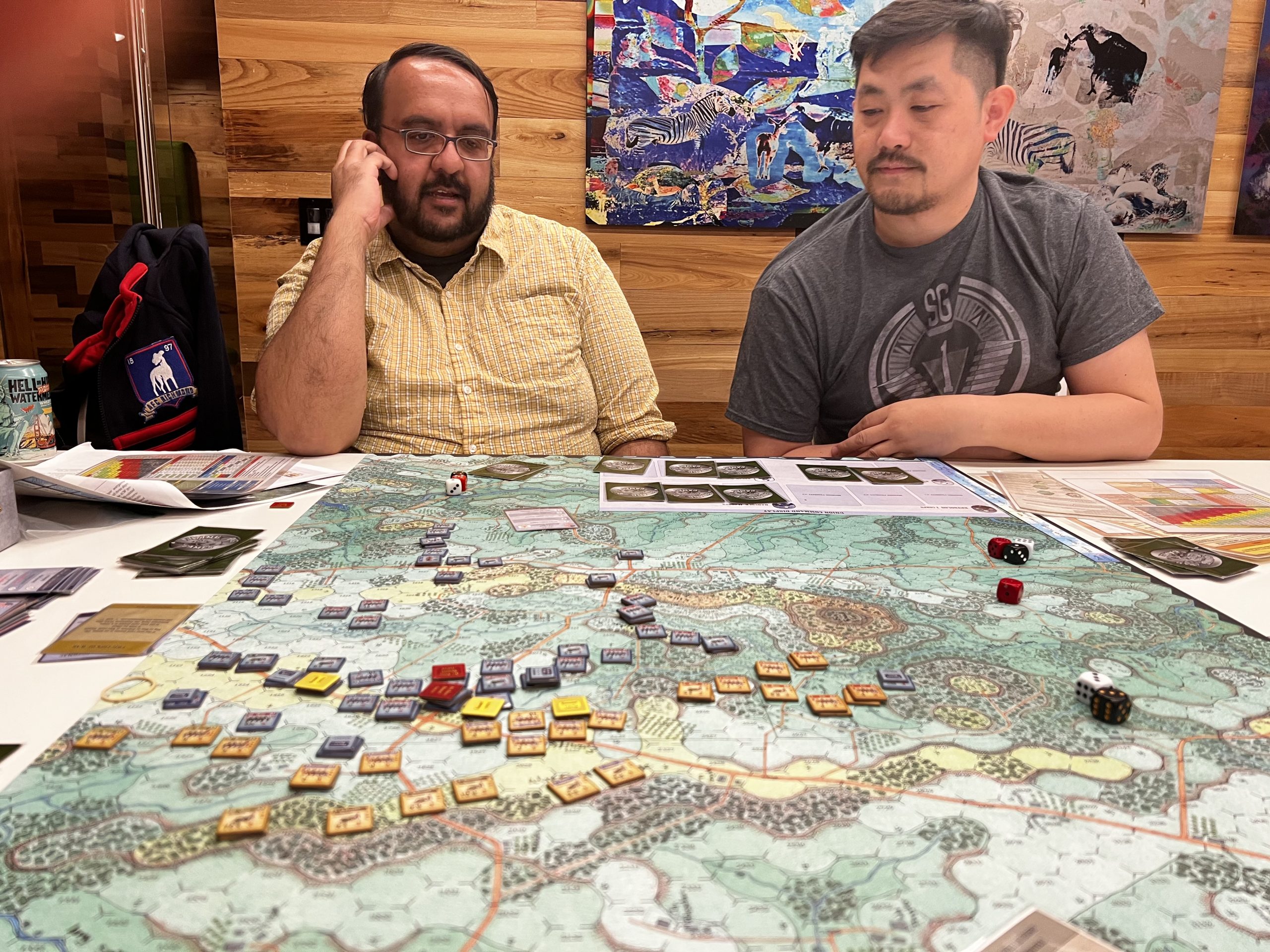
Despite the number of counters in the scenario, setup was quick, and being that it was our first time playing the game, my teaching did not take very long at all. One factor that was brought to my attention was that neither Sebastian nor Akar play ACW games, so their opinions would be interesting to hear.
We got into the thick of the fighting right away and found out that well-sited artillery really can make your opponent’s day rough. Even an infantry unit rolling with just a few strength points can have an impact with some good rolling.
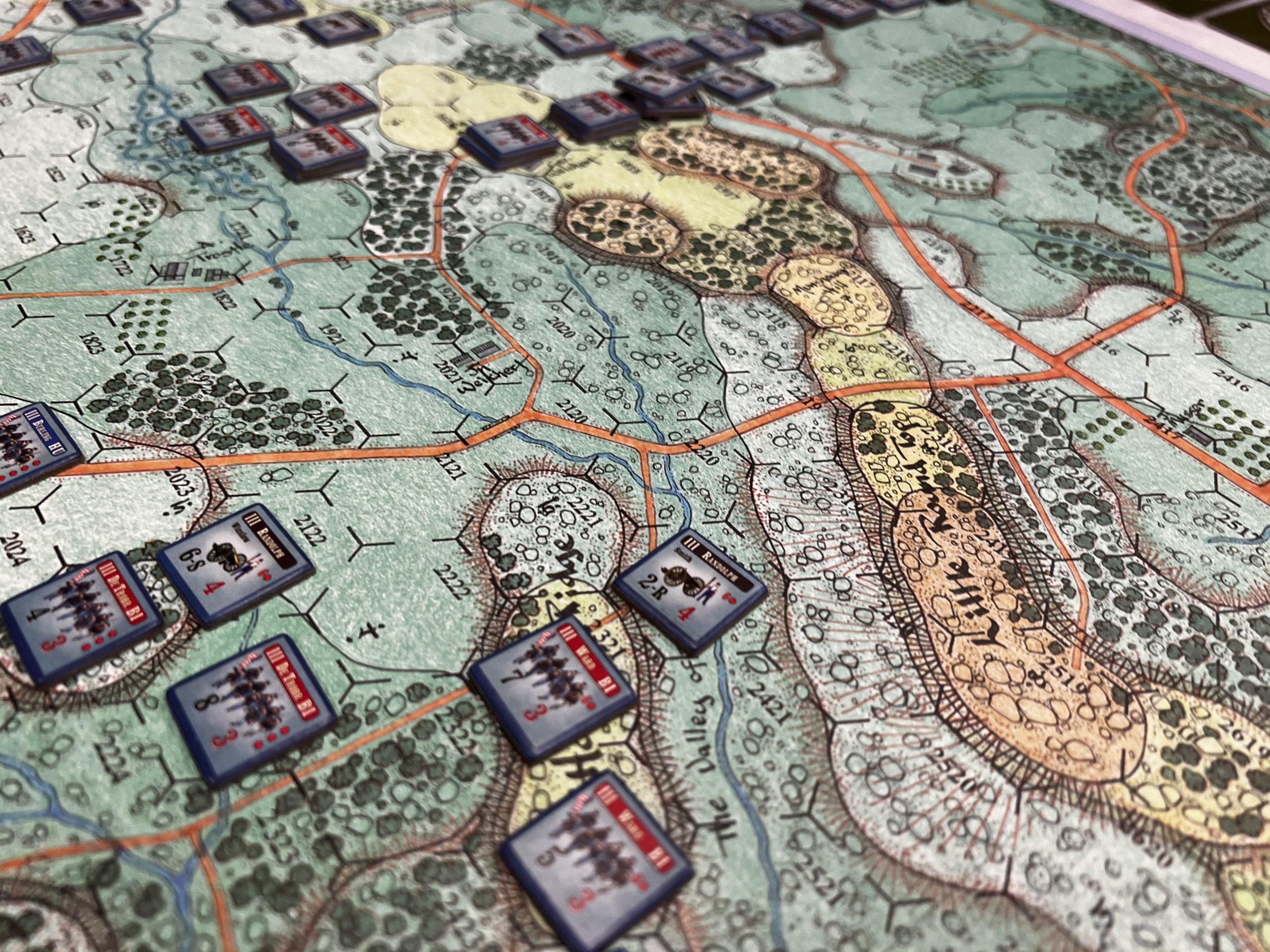
As I set my assault, the exposed III Corps position, the II and V Corps were trying to get in position to cover the weak flank of the Federal line. I was able to use my cards to slow down the advance of the V Corps and work my way into a good position.
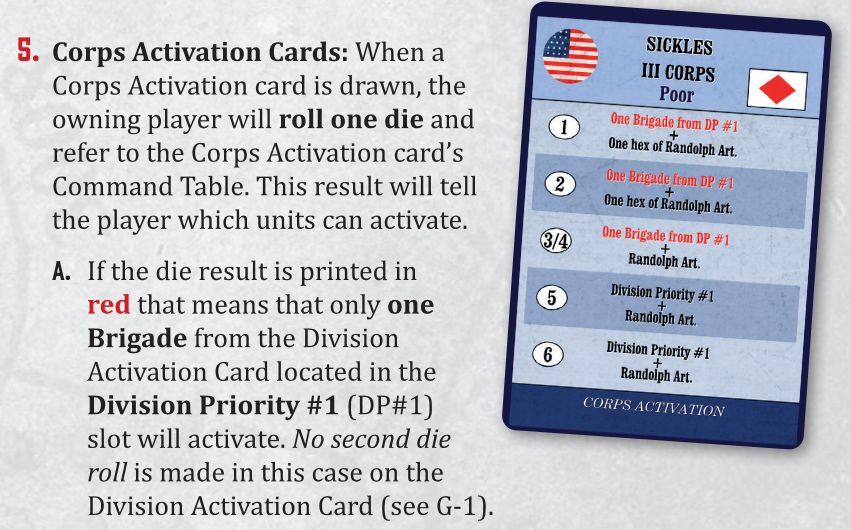
We only played a few turns and it was enough for Akar to tell me that the game was a lot of fun and even Sebastian liked it a lot. I have these two converted to ACW gaming and I will get them to play AFMS again.
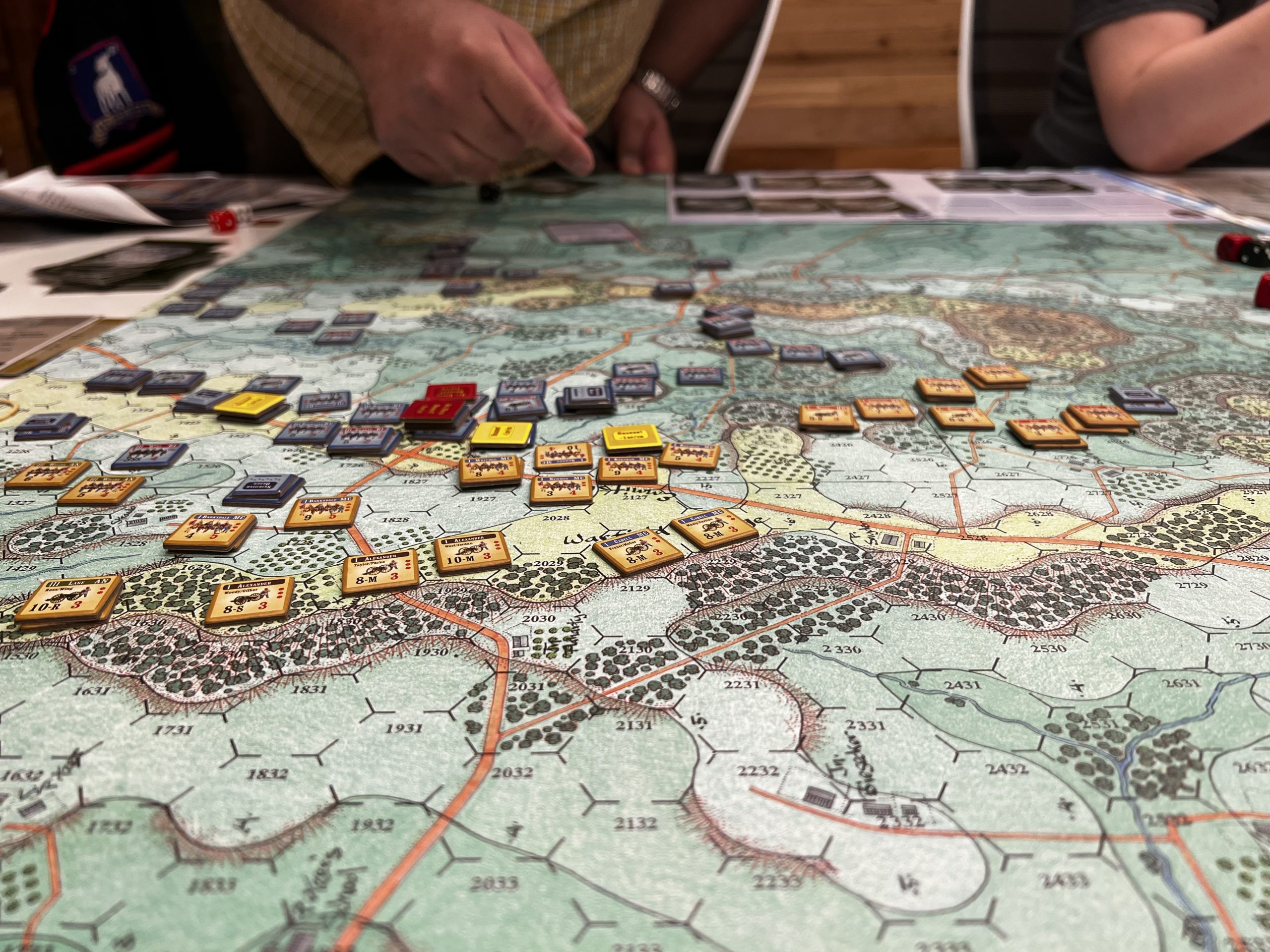
As we played the game the multi-player aspect we chose worked very well. Having the players act as corps commanders works in AFMS since I realized that the card deck itself acts as the overall army commanders, Meade and Lee.
Thoughts
I really loved this game. What I like most of all is how Hermann put so many subtle but impactful mechanics in the game without making the game unplayable. When reviewing the mechanics of the game I did not see anything that would make me feel the game was over-baked by putting in rules just for the sake of flavor. Many game designers do this in their games and it often distracts from gameplay that flows naturally. Designers put extra detailed rules such games with the goal to capture what they feel is an immersive experience when they should be making a game that is fun and enjoyable. AFMS succeeds at being a deep game that is not hard to play and is loads of fun.
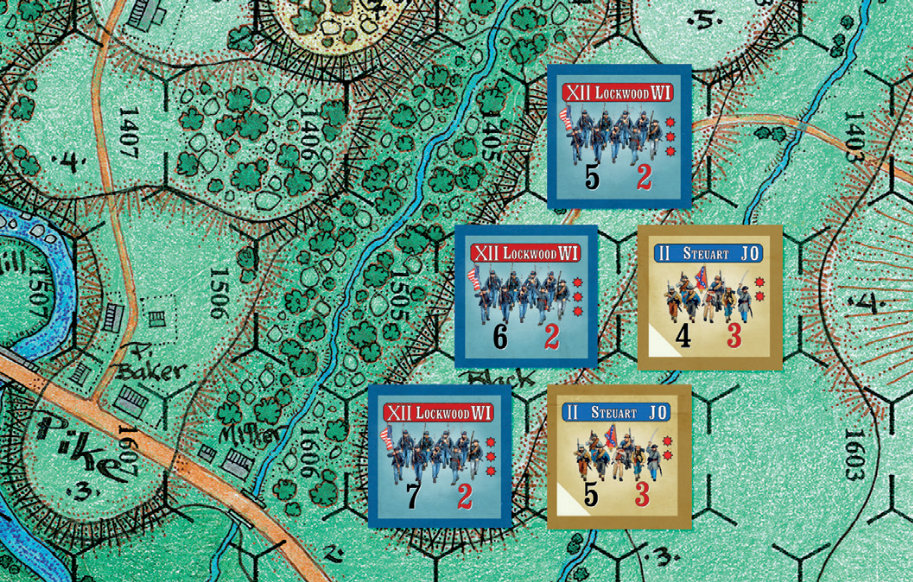
AFMS is an honest representation of ACW combat in an easy to play system that does not overburden the players at all. I found myself “in-the-game” at all times during a turn since I am looking to see what my opponent was doing so I can counter it and see if I can stop their actions.
I know many gamers dislike any game with a card-based activation system, they want full agency at all times, however, this is not how war works at any time. The cards add so much to the game in so many aspects that their exclusion would make the game just another game on Gettysburg.
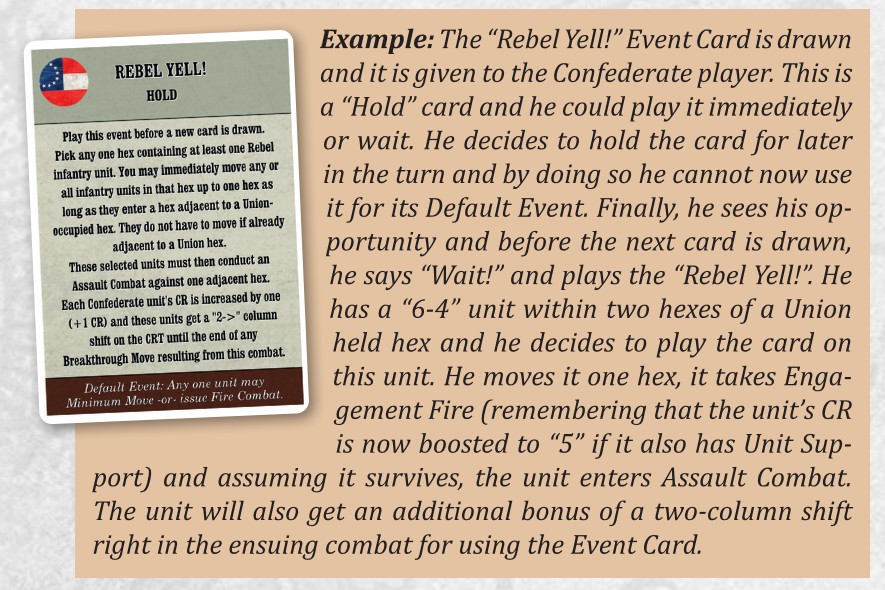
Questions many gamers ask, can you play this solo, well for any game the answer should always be yes, but this is not a solitaire game, and playing as such could be fun, however, the use of some of the cards makes a better with at least two players. I do feel that AFMS would be a very good multi-player game as well and if asked I would provide Hermann with a framework on how to do that.
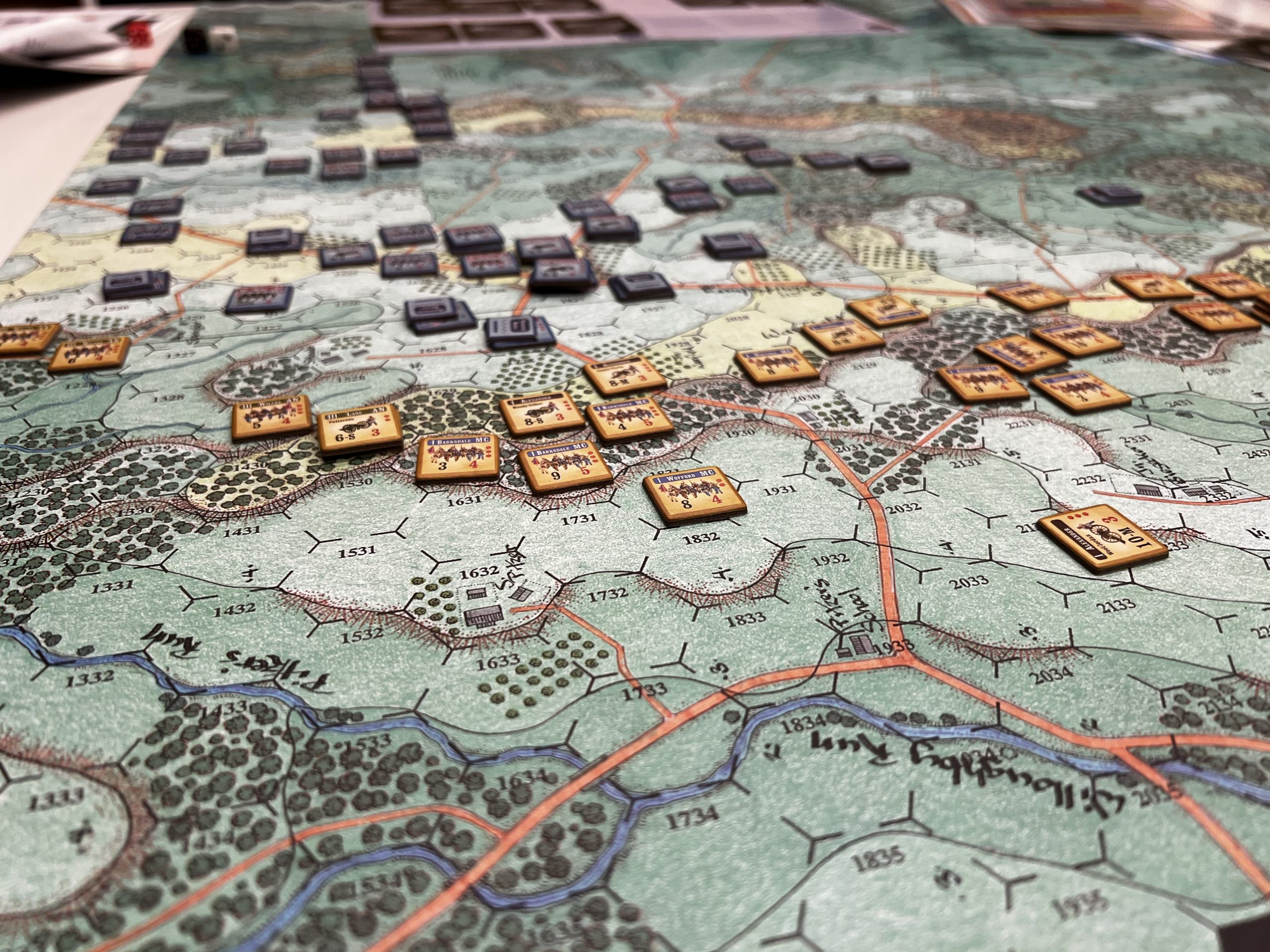
I feel this game is a must for any ACW gamers and I will even go as far as to say that this game is a must for any grognard who wants a great game that just looks amazing.
Akar’s Take;
“A Most Fearful Sacrifice might be the most beautiful hex-and-counter game I’ve played, but it’s not just a pretty face. The most impressive aspect of the game is its subtle handling of command and control, or more typically, the collapse thereof. Battles in the ACW were won and lost based on the competence and personality of the officers in charge, and this comes through clearly in the game. Giving orders as General Sickles felt real to his background as a political appointee famous for disobeying an order and suffering immense casualties as a result. The war feels realistically chaotic here; random chance can prevent orders from reaching a unit, and careful planning and prioritization can collapse immediately and drastically. This game isn’t for those afraid of luck, but if you care less about winning than in experiencing what fighting at Gettysburg must have felt like, this game is for you.”

Wow! Thanks so much for the terrific review! I’m so happy you all enjoyed the game as a multi-player experience as that is one of the aspects we really wanted to make possible with this design. I also appreciate that Akar and Sebastian are not experienced ACW players and nonetheless “felt” the ACW flavor in the game. Thanks again and good gaming!
Thanks for the kind comments gentlemen. I’m only going to comment on one thing. Rick Barber wrapped up the “Thunder at Dawn” map for me about two weeks before his death but in reality, he just put the finishing touches on it. This map was finished right before that map and this was Rick’s masterpiece. To be honest with you, we were a little worried that it was taking so long but when you are hand drawing something this large, it is going to take a long time. Though he didn’t indicate that he was ill (and probably didn’t know), Rick really poured his soul into this thing and it shows.
He never got to see the mounted version but even he would probably admit that he couldn’t improve on it.
What an excellent review Mitch. Sounds like a must have in the boardgame collection! Thank you!
Thanks, Mitch for the review, looks like a great game to add to the Civil War Collection.